Why Clay Pebbles are One of Our Top picks for Small Growers
Clay pebbles or hydroton (sometimes referred to as LECA—light expanded clay aggregate) are a hydroponic substrate with units about the size of marbles or peanuts. Because they’re so lightweight, easy for transplanting and harvesting, and easy on the hands, they’re a favorite of small producers using media bed or Dutch bucket techniques. Clay pebbles can be used in both hydroponic and aquaponic systems.
Read on for the pros and cons of using expanded clay pebbles like hydroton in your hydroponic or aquaponic systems.
Pros of Hydroton
1) High Pore Space Means Fewer Blockages
Larger aggregates like hydroton, pea gravel, and crushed granite have much larger space between each rock or pebble than perlite, sand, and other small particles. While the biological surface area isn’t usually as high, the pore space is much higher.
What does that mean? Larger pore spaces mean better percolation (flow of solution through the media), even when biofilms from algae and microbes cover the surfaces of the media, and even if some debris is captured in the pore spaces. Hydroton rarely becomes clogged or blocked, so water drains very effectively. This makes it a great option for ebb-and-flow systems and aquaponic media bed systems.
2) Some Air-Holding Capacity to Keep Root Zones Oxygenated
While it can’t rival perlite’s air-holding capacity (AHC), this grow media does have some capacity to hold air bubbles. Combined with great percolation, hydroton’s AHC makes it difficult for problematic anaerobic zones to occur.
3) Fairly Renewable & Environment-Friendly
Not much clay is used to make a cubic foot of hydroton, and clay is abundant, so most people consider it an environmentally-friendly medium to use. Compared to many media used in greater amounts that are more demanding of the earth’s supply, hydroton is very friendly to the environment.
4) Reusable
Although hydroton is a mineral and not considered a pollutant, we still don’t want it to end up in a landfill. Luckily, they are reusable almost indefinitely. You usually want to rinse any built up silt or organic matter from it before reusing it, but unless you have an extreme salt build up in it, you can reuse it many times.
5) Easy to Plant and Harvest
Hydroton is a loose media, so it’s easy to transplant and pull plants out of after harvest. Don’t underestimate how much time this can save you in wrestling with plant roots and separating root balls from the media surrounding them.
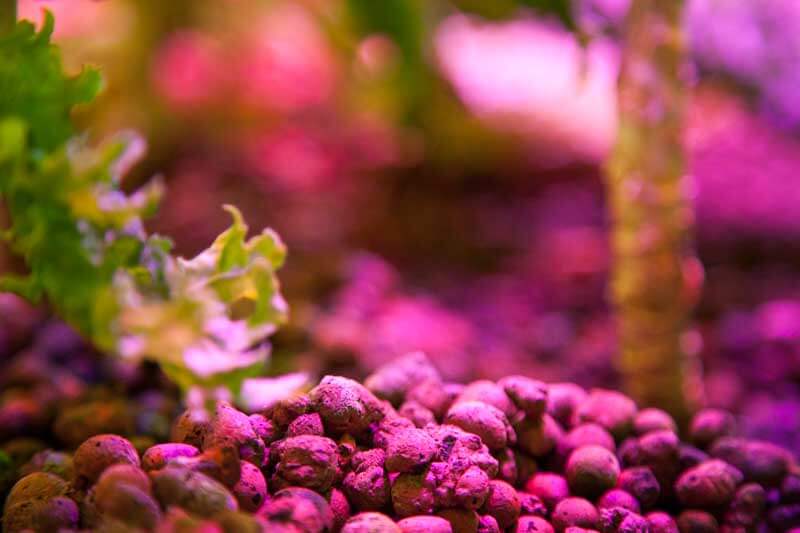
Hydroton is a loose media, so it’s easy to transplant and pull plants out of after harvest.
6) Good Colonization for Microbial Populations
While grow stones are smoother than some media, they are not so smooth as to discourage colonization by microbes. As you may know from our biological surface area resources, BSA provides habitat for the microbes which make nutrients from organic sources like fish feed available to plants. Less BSA means fewer microbes, which means a less responsive and less stable system. Though possessing less BSA than some media, this grow medium still offers high BSA.
Cons of Hydroton
1) Water Holding Capacity Leaves Something to be Desired
Clay pebbles don’t have good water holding capacity, or WHC. Since WHC is what allows a substrate to stay moist even after being drained, low WHC means that crops can get dry and wilted if not watered often enough. In some systems (with cooler climates, drought-tolerant crops, and/or constant irrigation) this is not an issue. Growers who have high transpiration rates, water-needy crops, etc. will need to figure out a way to keep the substrate moist.
Low WHC isn’t a big deal for most producers; just be aware of it and make sure you have frequent enough watering.
2) Fairly Costly
Hydroton is extremely easy to work with, which makes it a first choice for many small growers, but it’s a bit too expensive for most large growers to use it.
3) Can Cause Problems with Pumps and Plumbing
Because hydroton floats for the first few months until it’s been saturated, the pebbles can get sucked into filters or drain lines and cause blockages.
Tips on Using Hydroton
Hydroton is one of our first recommendations for small growers using media bed systems like the Hughey Aqua Farm or Dutch buckets. They’re easy to use and easy to source (Hort Americas is also a trusty supplier).
Tip: If you’re using new hydroton, remember to rinse it once before using; it can be dusty and cause clogging problems in mesh filters or drippers.
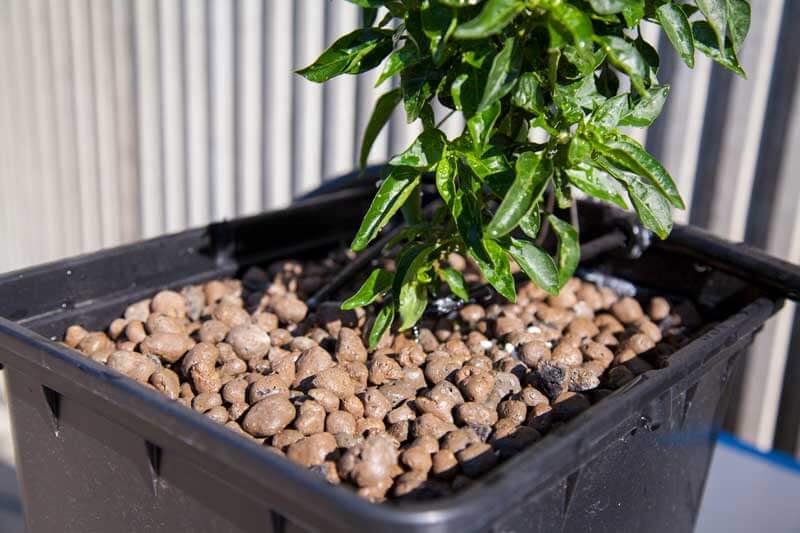
Need More Info on Hydroponic and Aquaponic Substrates?
The substrate decision can be overwhelming. That’s why substrate experts Chris Higgins and Farmer Tyler from Hort Americas presented an entire course on choosing the best hydroponic substrate.
In the Choosing a Substrate course, learn about:
-
- Holistic decision making
- Special considerations for choosing a substrate
- Organic substrates
- Plugs for hydroponics
- Media for microgreens
New to Upstart University? Sign up for a month of courses including this one for only $9.99 today.
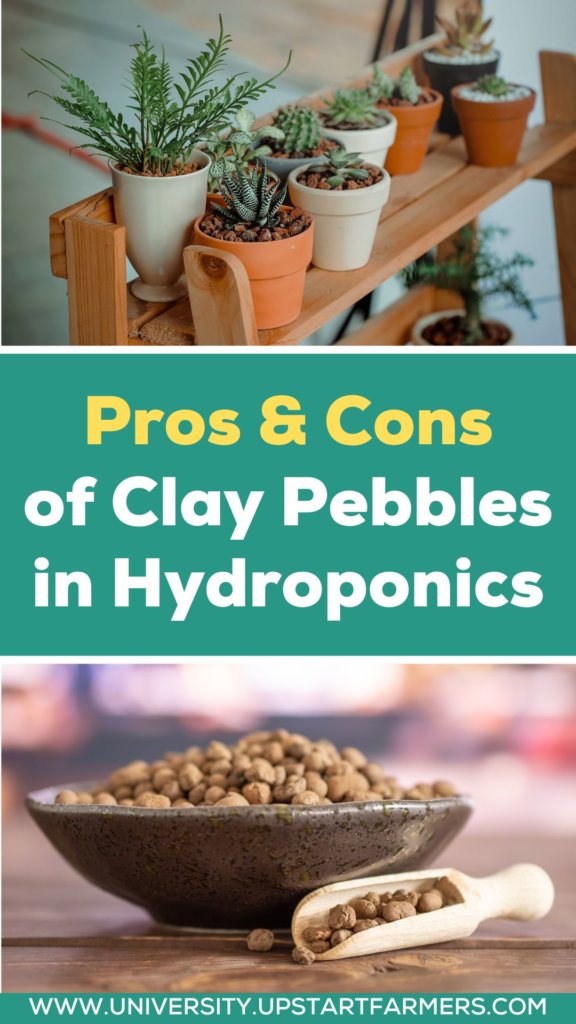

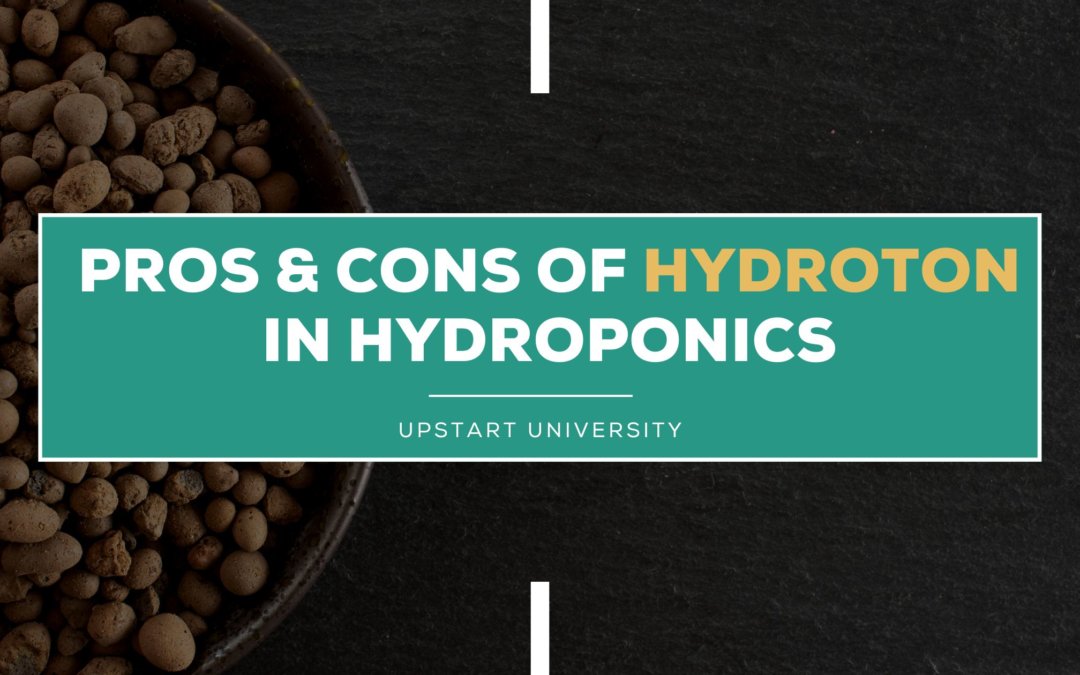
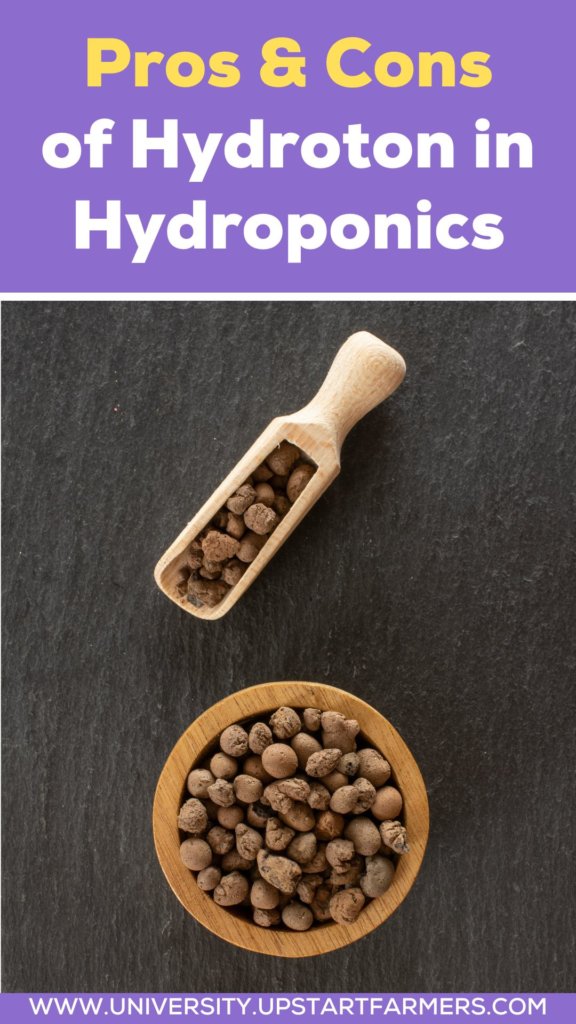


Other con could be the fact that Hydroton increase the ph? I have this issue with my orchids
Hi Marco,
Hydroton can affect the pH of your nutrient solution—here is a guide to using it properly
What happens to roots when the pebbles aren’t rinsed enough?
We are considering using Hydroton in rooftop planters to decrease weight, but the irrigation system will be Netafim drip line, not a hydroponic system. The low WHC is a concern since we will be using medium water requiring plants in sunny hot locations in California, and sizes will be one gallon to 4″ pots; some annuals and others perennials. Of concern too is proper fertilization for maximum performance. Given this information, might it make sense to use this product in combination with a potting soil mix, to have the benefits of both? If so, is there a proportional recommendation? Thanks so much.
Hi Gary,
Hydroton probably won’t offer much weight savings when saturated compared to most potting soils. Perlite, pumice, or “grow stones” are light-weight alternatives. In addition, appropriately sizing and positioning drip emitters will prevent any dry areas within the pots.
I am a new grower (Once 10 years ago don’t count much) and use the Hydroton in my DWC, Bubble Buckets and I covered the top 1-3 inches of my Fox Farms Soil 3 gallon Smart Pots with the Hydroton or Clay Pellets. I saw a Master Grower doing it to all his Soil Bags so I’m trying it. So far it’s keeping my Smart Pots soil moist for 3-5 days longer than w/o Hydroton. I have one 5 gl. Smart Pot that I’m trying to grow as a mother. Question though, have you ever heard or saw this before?? Is it safe for the plants or am I slowly killing them??lol
Hi Douglas,
There isn’t any reason it should be killing them unless the top cover gets fungus or algae accumulation over time. Also, the smart pots should reduce the risk of root rot with the soil staying moist for longer.
I’ve read about people growing succulents, but I never saw that myself. Is it the same grain size or smaller?
I’m asking because pumice is much harder to find. My succulents are Haworthias and other related plants.
I use a hydrofarm flow gro system that has 2gal sites. I am having issues using hydroton. It seems like my plants are always showing signs of too much water or over feeding and deficiency. All at the same time. My clones go in great then once they go into the hydroton they just lock up. Dont even want to flower. I have good air flow, humidity is around 50%,iv tried everything i know. Fan leaves are dark and curled and new growth is thin and light colored. I use GH 3 part and keep the ph around 6. My room is 78-80 day and 70 at night and my resi is cooled. I have a 1000 hps. Iv recently changed the buckets to a top feed rather than flood/drain. Do you have any recommendations? I used perlte/ vermiculite my entire life wirh no problems. But vermiculite is not available where I live. This is getting frustrating. My ec is about 1.6-1.8
I’m new to growing but maybe add a good dose of H2O2.
Hi Mike, I’m new at this.
But maybe try adjusting the strength of your nutrient solution?
Hello! I have a bag of this and had two questions in regards to it’s use.
Firstly, why (when I crush it up) is the center black and somewhat sparkly? I’ve never seen black clay before (the outside of it is the traditional reddish brown clay)?
Secondly, I saw you mentioned use in aquaponics systems, however I keep aquariums with invertebrates. I wanted to do a dirted tank and thought to add these to the dirt portion of the substrate before covering with a light layer of gravel. I keep Apple Snails and Dwarf Shrimp who are great in a higher pH but have issues with copper and copper based ores. In your opinion, do you think using these in the substrate would be safe for my invertebrates? Thanks so much for any and all replies!
Regards
why the Hydroton – Clay stone changed to white when it is old?
is it any fungus growth??
Hi there—that could be from salts and carbonates.
Thanks for the help. I need to get rid of blockage and this seems like it will do the trick
Can these be used in my Koi pond for my lotus plants which are in pots?
I bought some expanded clay gravel to use for my indoor cactus and succulents. The place I bought them from also has lots of fertilizer for sale and the clay absorbed the smell of ammonia from the fertilizer. How would I get the ammonia smell out? Boiling them? Just letting them air out?
Thanks
Bill
Hi Bill, the expanded clay shouldn’t have any ammonia smell. If you rinse it, it should go away. You may want to look for the cause of the ammonia smell–it’s definitely not good because plants can’t take up ammonia. It probably means that the microbes in the system are not converting the ammonia into nitrate–there may just be too much in the system.
What is the pH of Hydroton out of the bag?
Hi Bo P,
Hydroton has a neutral pH.
Watched someone take reading on YouTube and ph was 8!
7.2
One issue with expanded clay you don’t hear much about is abiotic consumption of nitrogen through the nitrogen cycle. The inner part of the pebbles is a perfect environment for this bacteria. This is why I prefer pearlite. I also don’t get sludge with pearlite.
how deep or how thick of the Hydroton can i have in the container? Should i use a 8″ deep tray or deeper tray? i am planning to set up a aquaponic with siphone bell. thank you.
A deli-style dispensary is a unique concept in the world of cannabis retail, offering customers a new and convenient way to purchase their favorite products. At a deli-style dispensary